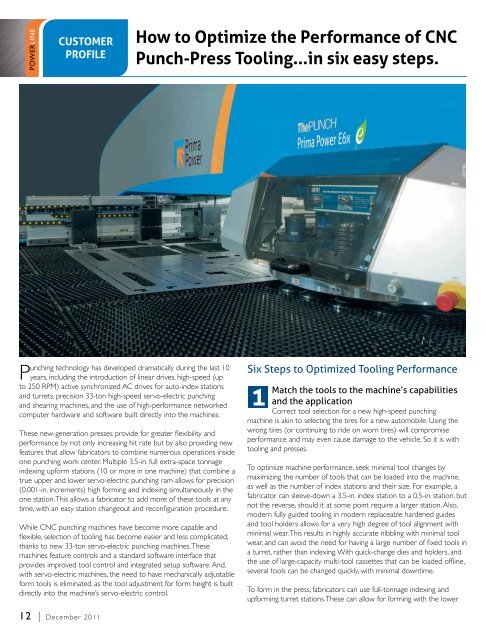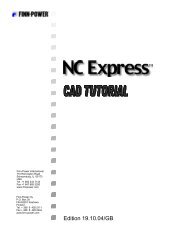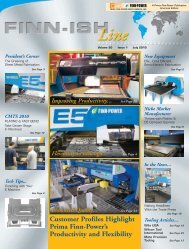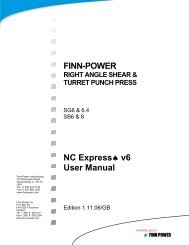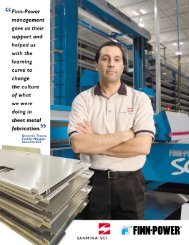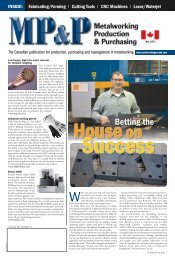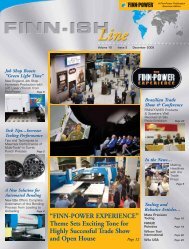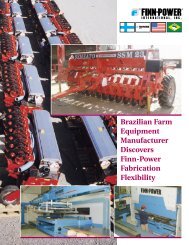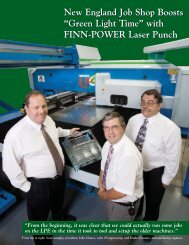Tooling Articles... Advanced Automation Enhances ... - Prima Power
Tooling Articles... Advanced Automation Enhances ... - Prima Power
Tooling Articles... Advanced Automation Enhances ... - Prima Power
You also want an ePaper? Increase the reach of your titles
YUMPU automatically turns print PDFs into web optimized ePapers that Google loves.
POWERLINE<br />
CUSTOMER<br />
PROFILE<br />
Punching technology has developed dramatically during the last 10<br />
years, including the introduction of linear drives, high-speed (up<br />
to 250 RPM) active synchronized AC drives for auto-index stations<br />
and turrets, precision 33-ton high-speed servo-electric punching<br />
and shearing machines, and the use of high-performance networked<br />
computer hardware and software built directly into the machines.<br />
These new-generation presses provide for greater flexibility and<br />
performance by not only increasing hit rate but by also providing new<br />
features that allow fabricators to combine numerous operations inside<br />
one punching work center. Multiple 3.5-in. full extra-space tonnage<br />
indexing upform stations (10 or more in one machine) that combine a<br />
true upper and lower servo-electric punching ram allows for precision<br />
(0.001-in. increments) high forming and indexing simultaneously in the<br />
one station. This allows a fabricator to add more of these tools at any<br />
time, with an easy station changeout and reconfiguration procedure.<br />
While CNC punching machines have become more capable and<br />
flexible, selection of tooling has become easier and less complicated,<br />
thanks to new 33-ton servo-electric punching machines. These<br />
machines feature controls and a standard software interface that<br />
provides improved tool control and integrated setup software. And,<br />
with servo-electric machines, the need to have mechanically adjustable<br />
form tools is eliminated, as the tool adjustment for form height is built<br />
directly into the machine’s servo-electric control.<br />
12 December 2011<br />
How to Optimize the Performance of CNC<br />
Punch-Press <strong>Tooling</strong>...in six easy steps.<br />
Six Steps to Optimized <strong>Tooling</strong> Performance<br />
1<br />
Match the tools to the machine’s capabilities<br />
and the application<br />
Correct tool selection for a new high-speed punching<br />
machine is akin to selecting the tires for a new automobile. Using the<br />
wrong tires (or continuing to ride on worn tires) will compromise<br />
performance and may even cause damage to the vehicle. So it is with<br />
tooling and presses.<br />
To optimize machine performance, seek minimal tool changes by<br />
maximizing the number of tools that can be loaded into the machine,<br />
as well as the number of index stations and their size. For example, a<br />
fabricator can sleeve-down a 3.5-in. index station to a 0.5-in. station, but<br />
not the reverse, should it at some point require a larger station. Also,<br />
modern fully guided tooling in modern replaceable hardened guides<br />
and tool holders allows for a very high degree of tool alignment with<br />
minimal wear. This results in highly accurate nibbling with minimal tool<br />
wear, and can avoid the need for having a large number of fixed tools in<br />
a turret, rather than indexing. With quick-change dies and holders, and<br />
the use of large-capacity multi-tool cassettes that can be loaded offline,<br />
several tools can be changed quickly, with minimal downtime.<br />
To form in the press, fabricators can use full-tonnage indexing and<br />
upforming turret stations. These can allow for forming with the lower


